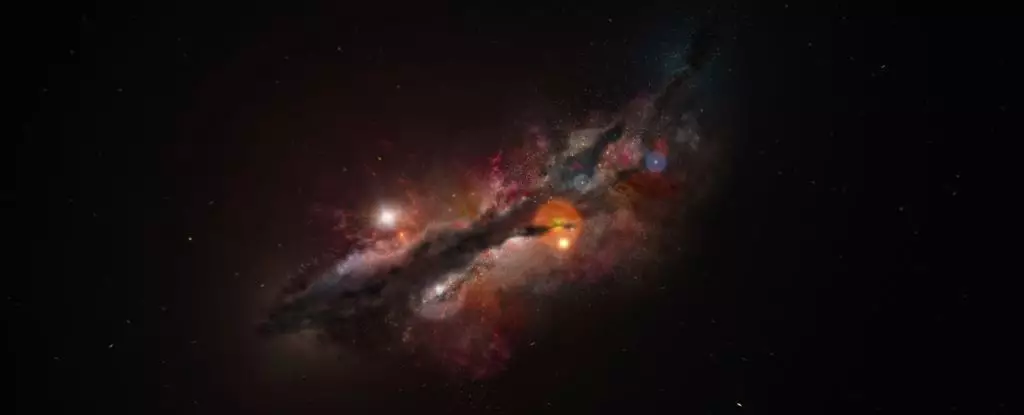In a remarkable twist that challenges our understanding of cosmic evolution, astronomers have unveiled a galaxy with an abundance of oxygen just 300 million years after the Big Bang. The galaxy, designated JADES-GS-z14-0, defies the long-standing belief that only lighter elements existed in significant quantities during this period. Given that the early Universe was thought to be primarily composed of hydrogen and helium, the presence of heavier elements raises a plethora of questions about the timeline and processes involved in the formation of galaxies.
The discovery, celebrated by researchers as a watershed moment, highlights a crucial aspect of cosmic history. Sander Schouws, a cosmologist at the Leiden Observatory, likened the find to encountering an adolescent when one would only expect to see infants in cosmic terms. Such a comparison emphasizes the rapid maturation of galaxies, suggesting that they are capable of evolving at a pace far beyond what was previously comprehended.
Challenging Traditional Models of Cosmic Growth
The implications of JADES-GS-z14-0 extend deep into the foundations of cosmological models. Traditionally, it has been thought that galaxies require vast amounts of time to grow and develop. To be observable across 13.4 billion light-years, JADES-GS-z14-0 must not only be extraordinarily large but also exceptionally luminous. The existence of such a galaxy presents a formidable challenge to existing theories concerning galaxy formation.
A galaxy’s ability to produce oxygen is intricately linked to the lifecycle of massive stars, which fuse lighter elements into heavier ones. This process is typically slow, requiring these stars to live and die, releasing the products of fusion through supernova explosions. The stark reality uncovered by the research team using the Atacama Large Millimeter/submillimeter Array (ALMA) is that JADES-GS-z14-0 contains an oxygen abundance ten times higher than anticipated. This revelation indicates not merely an anomaly but potentially a widespread phenomenon requiring a reconsideration of our cosmic chronology.
How Did Heavy Elements Form So Early?
The existence of significant amounts of oxygen in the early Universe challenges deeply rooted assumptions about the timescales involved in stellar evolution and element production. Astrophysicist Stefano Carniani remarked on the astonishment elicited by the discovery, pointing toward a new perspective on galaxy development in what can be described as the Universe’s infancy. This sudden maturity raises critical questions concerning the initial conditions necessary for galaxy formation and the processes that allowed for such rapid element synthesis.
As we delve deeper into this cosmic enigma, one must confront the fundamental tenets of our understanding concerning how galaxies coalesced and evolved during the first billion years. The accelerated formation of JADES-GS-z14-0 suggests that the interactions between dark matter and baryonic matter, alongside hydrodynamic processes in the nascent Universe, were more complex and efficient than previously acknowledged.
The Expanding Universe and Redshifted Observations
The exploration of galaxies like JADES-GS-z14-0 is made possible through advancements in astronomical technologies, particularly the James Webb Space Telescope (JWST). This powerful infrared observatory is uniquely structured to detect redshifted light from distant celestial objects, allowing researchers to explore the Universe’s evolution on unprecedented scales.
Given that the Universe is expanding, light from ancient galaxies has been stretched into longer wavelengths—often shifting from visible light into the infrared spectrum. JWST’s capabilities not only empower astrophysicists to survey more objects from earlier epochs but also serve to illuminate the pathways through which galaxies evolved in a constantly changing cosmic landscape.
Implications for Our Cosmic Framework
The implications of these findings are profound and far-reaching. JADES-GS-z14-0 exemplifies a growing trend of discovering more massive galaxies earlier in the Universe’s history than theoretical frameworks allow, reshaping our understanding of the conditions that led to galaxy formation. Each new observation adds complexity to an already intricate picture, pushing scientists to reconsider their models and assumptions regarding cosmic evolution.
As researchers continue to dissect the implications of JADES-GS-z14-0, it becomes clear that we are on the cusp of a paradigm shift in our understanding of the Universe. The framework we once relied upon for explanations of cosmic growth is now under scrutiny, forcing us to reevaluate the timelines of galaxy formation, elemental synthesis, and the overall development of the cosmos. The quest for knowledge continues—where will it lead us next?


Leave a Reply